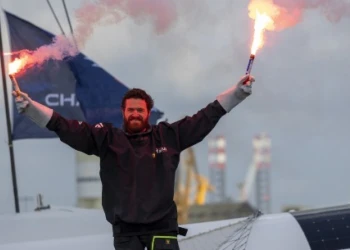
© Yann Riou - polaRYSE - GITANA SA
Arkéa Ultim Challenge-Brest: Friday race update
At 1600 nautical miles to Cape Horn race leader Charles Caudrelier has paused his attack and slowed Maxi Edmond de Rothschild down to 6.5kts whilst he waits for two brutal storm systems to pass him by and ensure he does not get hammered at Cape Horn. His lead over second placed Armel Le Cléac'h (Maxi Banque Populaire XI) is 3,360 nautical miles, or about five days. Le Cléac'h has routed north of New Zealand to miss a nasty storm phase but he is still making more than 30kts averages eastwards. Thomas Coville (Sodebo Ultim 3) is pit-stopped in Hobart in third place. In fourth Anthony Marchand (Actual Ultim) is 1600 miles from Cape Leeuwin and making modest progress in a complicated weather system. Adagio (Éric Péron) is 700 miles or so north west of the Kerguelens and making good miles.
ARKÉA ULTIM CHALLENGE-Brest, The Routers Replay the Week
Every Friday of the ARKÉA ULTIM CHALLENGE-Brest we talk to the on-shore routers. It has not been an easy week with one thing or another. Anthony Marchand and Éric Péron both had to make a stopover in Cape Town, Thomas Coville is in Hobart while Armel Le Cléac'h has had to pass Tasmania then New Zealand to the North. And runaway race leader Charles Caudrelier has decided to slow right down to let two strong depressions sweeping Cape Horn pass south of him. Talking these events over, and more this week are Nicolas Lunven (Banque Populaire), Philippe Legros (Sodebo) and Yves Le Blevec (Actual).
Dealing with realities.
Nicolas Lunven (Banque Populaire): "Our thinking has gradually evolved and matured. Seeing the prospect of very challenging conditions, the reality of 50 to 60 knots winds, 8 meter seas, we really did wonder if it was reasonable to continue in these conditions. We discussed things a lot before agreeing to take this option (passing through the Bass Strait then north of New Zealand). It's not the optimal route at all but we can't see ourselves taking any unnecessary risks this way."
Philippe Legros (Sodebo Ultim 3): "Way back when, we missed the train and since then we have suffered a lot with the weather. We tried to make the most of the situation to try to combine good fast spells with repair phases. We had to adapt to the weather and take care of the boat and the technical needs. There are constraints which you have to factor in to the routing and this complicates decision-making. Thomas managed to find an alternative system to make his foil work. But we realized that there was a danger for him with each manoeuvre, especially with the conditions he had at the time. And when we saw what was coming, it became unviable and that's what pushed us to this stopover in Hobart."
Yves Le Blevec (Actual Ultim 3): "Anthony's week started with the stopover in Cape Town. He left again early Saturday afternoon and we all got back into racing rhythm. From the first night, south of Good Hope, he had quite harsh conditions with wind, sea and currents. After that he progressed quite well. He had to manage a transition zone north of Kerguelen which he is in the process of getting out of. These were not very quick but an essential 48 hours passed, he left in more conducive conditions. 'Antho' is always full on, hyper determined and focused and you can feel it in our comms with him."
Upcoming. "Stay vigilant and stand strong"
Nicolas Lunven: "Armel should pass the north of New Zealand at the end of the night in order to avoid the big depression circulating in the south of the islands. Then he will begin to slant his route and head south-east. The conditions remain challenging with 20 to 25 knots of wind, seas of 3 to 4 meters, it is still complicated and tiring for moving around, eating, and doing things. We must remain vigilant and hold on."
Philippe Legros: "Our idea is not to delay leaving at all. We know that the conditions are still tough but if we wait until it is easier, we would not leave before Sunday or Monday. Thomas will therefore leave and throttle back for 36 to 48 hours while trying to deal with the violence of the elements. The weather does not allow us to take a very northern route like the Maxi Banque Populaire It won't be easy: Thomas has never been in such strong conditions since the start."
Yves Le Blevec: "For Antho it's going to be a lot of downwinds with a few gybes. We will have to balance between the optimal route and the reasonable route. The objective is to find the right dosage, to go quickly without putting yourself in conditions that are too difficult, too dangerous, too trying. Routing software has no qualms, it doesn't really think about the consequences for man and boat. We tend to weigh their proposals in order to preserve ourselves. »
The "Caudrelier break"
Yves Le Blevec: "Within the team we discussed about Charles' situation a lot yesterday and we all said to ourselves that he was going to have to slow things right down. And the Edmond de Rothschild team confirmed this this morning. Their objective is to finish the race, to increase their chances of going to the finish line. There was no point in getting yourself in such harsh conditions. Even being side by side with other competitors, the same question would have arisen. But here with their lead there is no need to risk things. They made a very good decision.
Nicolas Lunven: "I haven't really looked at his weather situation, we're focused on our route. But I think it's a good seamanlike decision, especially since they have a big lead. Passing Cape Horn is very delicate because you are in a funnel, the passage between the land and the ZEA is very tight. The Andes chain diverts wind flow and this accelerates the phenomena. It can turn into nasty stormy cauldron, a situation somewhat similar to what Armel just saw in the south of Tasmania and New Zealand."
Philippe Legros: "It's a good decision. These are phases that we experience on a round the world. When you have to deal with the land on one side and the ZEA on the other, it's often quite narrow. And the place where it is narrowest is precisely at Cape Horn, a real bottleneck. By having to deal with the weather systems there are the time it all becomes more complicated, like what we see in New Zealand. But at Cape Horn, the entire Andes mountain chain helps make the weather even more violent. Extreme vigilance must therefore be exercised."





